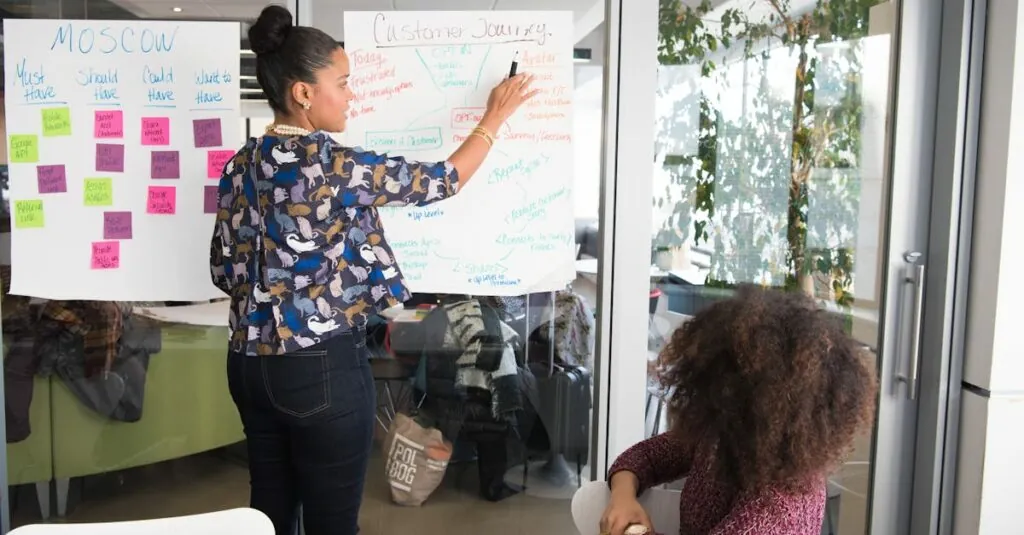Table of Contents
ToggleIn the chaotic world of teamwork, juggling tasks can feel like herding cats—frustrating and often messy. But fear not! With the right task management strategies, teams can transform that chaos into a well-oiled machine. It’s not just about keeping everyone on track; it’s about boosting productivity and making work feel less like a never-ending game of whack-a-mole.
Overview of Task Management for Teams
Task management for teams involves organizing and prioritizing tasks to enhance collaboration and workflow. Effective strategies can create a structured environment where team members understand their responsibilities and deadlines. Regularly scheduled check-ins or updates help maintain transparency and accountability among team members.
Task management tools provide features that streamline communication, enabling teams to share updates in real-time. These tools often include features such as task assignment, deadline tracking, and progress monitoring. Using these resources promotes clarity and reduces confusion about tasks.
Prioritization plays a critical role in task management. Teams should focus on high-impact tasks that align with overall goals. Mapping out tasks based on urgency and importance can help teams allocate resources effectively, ensuring that critical projects receive the attention they deserve.
Centralizing all tasks in a shared platform allows for easier oversight and quick adjustments as priorities change. Adopting a flexible approach ensures that teams can adapt to shifting demands while still meeting deadlines.
Visual aids, such as kanban boards or Gantt charts, can make task distribution more manageable. Such tools provide clear insight into each member’s workload and progress, fostering a sense of teamwork. They also highlight dependencies, enabling teams to address potential bottlenecks proactively.
Ultimately, successful task management hinges on clear communication and collaborative planning. By employing structured strategies and utilizing appropriate tools, teams can transform their productivity and drive more effective outcomes.
Benefits of Effective Task Management
Effective task management leads to significant advantages for teams. It streamlines processes and enhances overall performance.
Improved Productivity
Improved productivity emerges from clearly defined tasks and priorities. Team members achieve more when they know urgent items and can focus on high-impact efforts that align with team goals. Tracking progress with task management tools simplifies monitoring, allowing adjustments when needed. Quick access to task updates keeps everyone in the loop. Regular check-ins help identify bottlenecks early, preventing project delays. Efficient work processes prevent confusion and reduce time spent on unimportant activities. By prioritizing tasks, teams can navigate challenges more effectively and ensure that crucial deadlines are consistently met.
Enhanced Collaboration
Enhanced collaboration arises when teams use effective task management strategies. Centralizing tasks in a shared platform improves transparency and accountability among team members. Clear visibility into each person’s responsibilities fosters cooperation and reduces overlaps. Teams that prioritize tasks based on urgency and importance work together more seamlessly. Communication tools integrated into task management platforms help facilitate discussions, ensuring everyone is aligned. Visual aids like kanban boards enhance the collaborative process by providing a shared view of progress. Consequently, team members feel more engaged and empowered to contribute, ultimately driving higher-quality results.
Popular Task Management Tools
Numerous tools streamline task management for teams. These applications enhance collaboration, organization, and productivity.
Tool Comparison
Several popular tools exist for task management, including Trello, Asana, and Monday.com. Trello features a user-friendly kanban board layout, ideal for visual learners. Asana offers robust project tracking, allowing teams to set deadlines and assign tasks seamlessly. Monday.com emphasizes customization, catering to varied project needs. Choosing the right tool hinges on specific team requirements, such as size and project complexity. Teams benefit when selecting a tool that aligns with their workflow preferences and collaboration style.
Features to Consider
Essential features amplify the effectiveness of task management tools. Integration capabilities enable seamless interaction with other platforms, enhancing overall workflow. User-friendly interfaces attract team members by simplifying navigation. Customizable dashboards empower teams to track progress meaningfully. Automation features reduce repetitive manual tasks, saving time and increasing focus on high-impact items. Communication tools within the platform foster collaboration and reduce the need for external messages. Prioritization capabilities aid in focusing on urgent tasks, aligning with overall goals for maximum productivity.
Best Practices for Implementing Task Management
Implementing effective task management practices enhances team productivity and collaboration. Teams can utilize strategies to streamline their workflow while achieving clarity in task execution.
Setting Clear Goals
Establishing clear goals is essential for team alignment. Setting SMART goals—specific, measurable, achievable, relevant, and time-bound—provides direction. Teams should prioritize tasks aligned with their objectives to ensure meaningful outcomes. Specific examples of clear goals include defining project milestones and assigning roles accordingly. Clarity fosters accountability, allowing team members to understand their responsibilities. Remaining focused on high-impact initiatives improves overall effectiveness. Engaging all team members in the goal-setting process strengthens commitment and ownership.
Regular Check-Ins
Conducting regular check-ins holds teams accountable and boosts transparency. Weekly meetings or daily stand-ups encourage open communication about task progress and challenges. Team members can share updates, ensuring alignment and identification of roadblocks. Such touchpoints also promote collaboration and idea sharing among diverse perspectives. Listening to team feedback allows for timely adjustments that enhance productivity. Carefully scheduled check-ins provide opportunities for real-time prioritization adjustments based on project needs. This proactive approach maintains momentum toward goal achievement and reinforces team cohesion.
Challenges in Task Management for Teams
Task management for teams faces numerous obstacles that can hinder productivity and collaboration. Understanding these challenges helps teams implement effective solutions.
Common Pitfalls
Lack of clarity in roles often leads to confusion. When team members aren’t sure of their responsibilities, tasks can fall through the cracks. Deadlines frequently become overlooked or ignored, making progress difficult. Communication gaps can further exacerbate issues, resulting in misunderstandings about task priorities. Resistance to using new tools also poses a challenge, as some team members may prefer established methods. Finally, micromanagement can stifle creativity, limiting team members’ ability to work autonomously and efficiently.
Strategies for Overcoming Challenges
Establishing clear roles and responsibilities is crucial. When team members know their tasks, accountability improves. Setting specific deadlines helps keep projects on track, ensuring everyone remains aligned. Regular check-ins foster communication, allowing for timely updates and addressing concerns as they arise. Utilizing task management tools simplifies assigning, tracking, and managing tasks. Encouraging feedback creates a culture of collaboration and continuous improvement. Prioritizing high-impact tasks based on deadlines and relevance to project goals allows teams to focus on what truly matters, enhancing productivity.
Effective task management is crucial for teams aiming to boost productivity and collaboration. By adopting the right strategies and tools, teams can navigate challenges and transform their workflow. Prioritizing tasks and maintaining clear communication fosters accountability and ensures everyone stays aligned with project goals.
Utilizing visual aids and centralized platforms enhances oversight and adaptability, making it easier to adjust to changing priorities. With the right approach to task management, teams can achieve higher-quality results while simplifying their processes. Embracing these practices not only leads to improved efficiency but also strengthens team cohesion, ultimately driving success.







